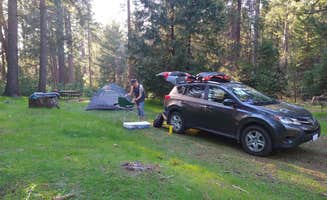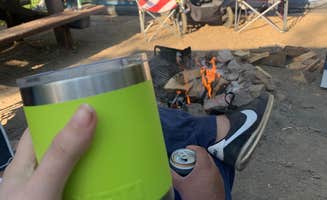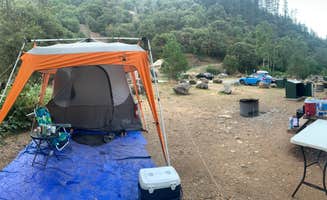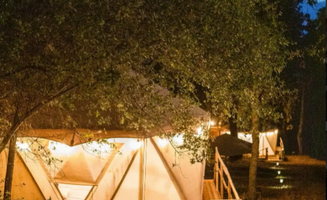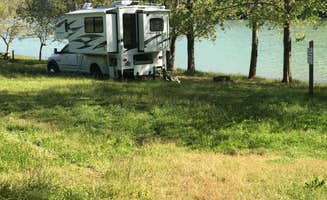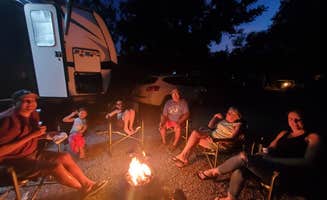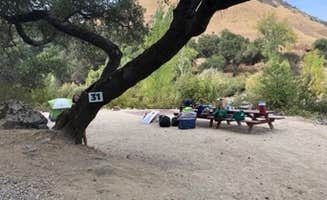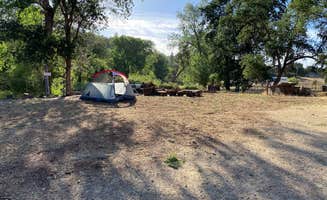Foresthill camping destinations range from primitive sites along the American River to more developed campgrounds with river access. The area sits at elevations between 1,500-3,000 feet in the Sierra Nevada foothills, creating varied terrain with oak woodlands and pine forests. Summer temperatures can reach 100°F while spring camping often coincides with wildflower blooms along hiking trails near many campsites.
What to do
Gold panning along American River: At Coloma Resort, visitors can experience California history through recreational gold panning. "If you ever want to experience the thrill of gold panning, and California history go here! You will not strike it rich, but with a couple hours of effort you can get a nice little bottle of gold flakes to take home with you," notes Jill F. The area includes access to historic sites like Sutter's Mill, making it educational for history enthusiasts.
Swimming in mountain reservoirs: Giant Gap Campground provides access to a reservoir ideal for paddleboarding. "Such a beautiful lake for paddleboarding as there are no motor boats. Quiet, secluded, flat campsites. There is a great trail that goes entirely around the lake," shares Nicki M. The 5-mile loop trail offers hiking opportunities with lake views throughout.
Mountain biking on forest trails: Ponderosa RV Resort offers trail access for mountain biking enthusiasts. "Lots of great trails to weave through the campground on a mountain bike," notes Kate A. Trails range from beginner-friendly paths along the river to more challenging routes through the surrounding foothills.
What campers like
River swimming access: Mineral Bar Campground features popular swimming holes with rocky pools. "Beautiful mountain valley of north fork. Clean campsites right along road with bearboxes, picnic tables, and fire pits. Easy river access down the hill to rocky swimming pools," writes Christian N. Many sites offer direct river views with quick access to cooling water during hot summer days.
Secluded forest setting: Dru Barner Campground provides a quiet atmosphere with substantial tree cover. "Nothing but trees and the wind blowing through them. It was an adventurous drive on a curvy mountain road to get here, but well worth it," says ProfG999. The campground sits approximately 6 miles from Georgetown, offering isolation while remaining within reach of supplies.
Heated amenities during cooler seasons: Inn Town Campground offers heated options for shoulder-season camping. "We even had a heated mattress pad in our glamping tent to keep warm," mentions Amanda M. The campground remains accessible year-round with amenities designed for variable mountain weather conditions.
What you should know
Road access limitations: Several campgrounds require navigation on narrow, winding roads. For Giant Gap Campground, Stephanie C. warns, "Be warned though, Google maps will suggest driving up Iowa Hill. DO NOT. Follow the directions of the campground, that road is not for the faint of heart. And NOT for RVs or trailers." Many forest roads become difficult to navigate during wet conditions.
Water availability varies: Water access changes seasonally at multiple campgrounds. At Dru Barner, one camper notes, "Bring water as there is none available due to poor quality." Mineral Bar Campground also requires campers to bring their own water supply, with no potable water available on-site.
Bear activity requires precautions: Bear activity requires proper food storage in several areas. Mineral Bar Campground provides bear boxes, with Jim N. reporting "have seen several bears" at this location. This necessitates careful food management and awareness of surroundings, particularly at dawn and dusk.
Tips for camping with families
Shaded sites for summer heat: When temperatures climb above 90°F, shade becomes essential. At Giant Gap Campground, Jessee A. shares, "We took our one year old and two dogs here and it was awesome. Close to the water which had a nice beach area. The bathrooms and campsites were very clean and the campground was surrounded by beautiful big trees and greenery. Very peaceful."
Swimming options for different ages: Lake Clementine Boat In Campground offers swimming opportunities with varying depths. Drew M. notes, "The river is extremely clean and clear with good temperature." Sites 1-6 offer minimal shade while higher-numbered sites provide more tree cover for afternoon breaks from the sun.
Accessible hiking trails: Several campgrounds feature beginner-friendly trails suitable for young hikers. "The Otter Creek Trail is a nice day hike though a bit of switch backing elevation to get down to the creek," mentions Lily S. about trails near Dru Barner Campground. Wildlife sightings, including "wild turkeys, deer, and birds" enhance these hiking experiences.
Tips from RVers
Site selection for larger vehicles: Campgrounds vary significantly in ability to accommodate larger RVs. Mike M. recommends Giant Gap Campground for accessibility: "Camped at Site 13 with an RV and a disabled father. We rode his e-tricycle (and I walked) all the way down to the lake and around it going clockwise."
Power considerations: Voltage fluctuations affect electronics at some campgrounds. David C. warns about American River Resort: "The power is not good. I had to bypass the surge suppressor because it kept cutting out due to low voltage. Voltage was generally 104-105." RVers with sensitive equipment should consider bringing generators where permitted.
Size restrictions on mountain roads: Many campgrounds have access limitations. Kimberly M. notes about Giant Gap, "They have quite a few paved, pull-thru sites which is super convenient. Some are more secluded than others." Most sites accommodate RVs under 30 feet, with specific campgrounds like Giant Gap offering better options for larger vehicles.


